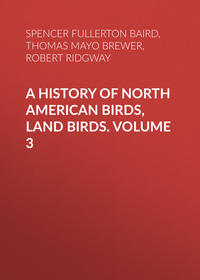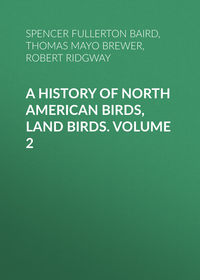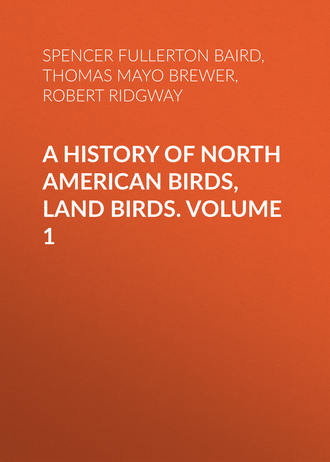 полная версия
полная версияA History of North American Birds, Land Birds. Volume 1
The one egg is pale blue, the large end rather thickly spattered with fine dots of black and ashy-lilac; is regularly or rather slightly elongate-oval, the small end rather obtuse. It measures .80 of an inch in length by .56 in breadth.
Genus ÆGIOTHUS, CabanAcanthis, Bonap. Conspectus, 1850, not of Bechstein, 1802, nor of Keys. & Blas. 1840.
Ægiothus, Cabanis, Mus. Hein. 1851, 161. (Type, Fringilla linaria, Linn.)—Coues, Pr. Acad. Nat. Sc. Phil. 1861, 373; 1863, 40; 1869, 180.
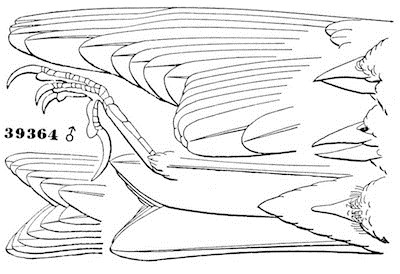
Ægiothus linarius.
39364 ♂
Sp. Char. Bill very short, conical, acutely pointed, the outlines sometimes concave; the commissure straight; the base of the upper mandible and the nostrils concealed by stiff, appressed bristly feathers; middle of the mandible having several ridges parallel with the culmen. Inner lateral toe rather the longer, its claw reaching the middle of the middle claw; the hind toe rather longer, its claw longer than the digital portion. Wings very long, reaching the middle of the tail; second quill a little longer than the first and third. Tail deeply forked.
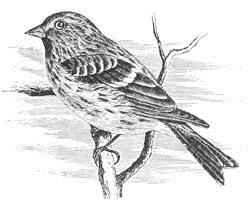
Ægiothus linarius.
Difficult as it sometimes is to define with precision the characters of closely allied species of birds, there are few genera where this is the case more strikingly than in Ægiothus. Leaving out of view the peculiar European species, it has been a mooted question whether North America, including Greenland, possesses one, two, or six species, owing to the strictly boreal distribution of these birds, and the fact that their summer resorts are seldom invaded by the naturalist. The necessary means of determining the proper distribution of the forms and the variations with season, locality, and sex, are scarcely to be met with in any public museum, that of the Smithsonian Institution, however, being the most complete in this respect.
To Dr. Coues, as quoted above, we owe the most satisfactory indications of the different species and varieties, his papers in the Proceedings of the Philadelphia Academy of Natural Sciences (1861, 375; 1863, 40; and 1869, 180) being models of ornithological criticism and discussion. His labors have enabled us to define with precision the various forms, both European and American, found in the genus, and have brought us to satisfactory conclusions in reference to their limitations.
Mr. Ridgway has lately made a careful revision of the specimens of Ægiothus in the Smithsonian collection, and with a general concurrence in the conclusions of Dr. Coues in regard to the differences observable, he suggests, as an application of the laws more recently verified by him and myself in our examination of the North American land-birds, that we may best consider the actual species to be two in number, namely, canescens and linarius, ranging the other forms under these, either as geographical races or as seasonal stages. Bearing in mind the general law that the more boreal or Greenland-born specimens should be larger than the more southern or Continental, and that the peculiar dark plumage of fuscescens and rostratus only occurs in summer breeding specimens, he considers these as identical with linarius and holbölli; the winter plumages respectively of the same two races of one species, linarius; the latter race, holbölli, being the larger or Greenland form. If fuscescens be darker than summer linarius from Europe, it is simply another instance of the darker tints of Arctic American birds as compared with European.
Ægiothus canescens and exilipes Mr. Ridgway considers as the Greenland (larger) and Continental (smaller) races of one species, which perhaps do not differ so much with season as do those of linarius. The differences in the size and proportions of bill, and perhaps of feet, Mr. Ridgway does not think of much importance, as great variations are observable in this respect in specimens from the same locality, and the actual differences of the bill are obscured by the greater length of the bristly feathers around its base in winter, making it appear considerably shorter. Indeed, Professor Alfred Newton maintains that the same bird will have the bill considerably longer in summer, after living on soft insect food, and shorter in winter when worn down by use on hard seeds. Mr. Ridgway finds, too, that specimens of linarius from Kodiak differ in a much longer and more slender bill than usual, in this respect resembling Alaska specimens of several other Fringillidæ.
The following synopsis expresses Mr. Ridgway’s views as indicated above: a critical examination of a series of more than two hundred specimens, in the collection of the Smithsonian Institution, being the basis of his conclusions.—S. F. B.
Species and VarietiesCommon Characters. Adult. Above streaked with dusky upon a brownish, or brown and whitish, ground; wing-coverts tipped with whitish or pale brown. Beneath whitish, streaked on the sides with dusky. An indistinct, lighter superciliary stripe. Male. Rump tinged with rose-pink. Female. Rump not tinged with pinkish. Juv. Without any red, and with the whole lower parts thickly streaked.
A. Crown with a quadrate patch of crimson, in adult; throat and chin with a dusky spot; quills and tail-feathers not edged conspicuously with white. ♂ with the breast tinged with red.
1. A. canescens. Rump unstreaked white (both sexes, at all seasons); the lower tail-coverts with white shafts; the red tinge on the breast in the ♂, of a delicate pale rosaceous pink tint.
Bill very short and thick, its height through the base nearly equalling the length of the culmen. Wing, 3.20; tail, 2.65. Bill: culmen, .35; height, .30. Hab. Greenland … var. canescens.
Bill much smaller, more acute, its height through the base much less than the length of the culmen. Wing, 3.00; tail, 2.50. Bill: culmen, .30; height, .22. Hab. Continental arctic America … var. exilipes.
2. A. linarius. Rump always streaked; lower tail-coverts with dusky shaft-streaks; the red tinge on the breast of the ♂ of a rosaceous-carmine tint.
Bill about .35 in length by .22 in height; wing, 2.80; tail, 2.40. Hab. Continental arctic and cold temperate North America … var. linarius.
Bill about .40, or more, in length, by .30 in height; wing, 3.20; tail, 2.60. Hab. Greenland in summer, and Continental arctic and cold temperate North America in winter … var. holbölli.
B. Crown without any red; throat and chin without any dusky spot; quills and tail-feathers of adult male edged conspicuously with white. ♂ without red tinge on the breast.
3. A. flavirostris. Rump rose-pink in the ♂, brown streaked with dusky in ♀. No red on crown or breast.
♀. Above umber-brown streaked with dusky; ground-color of rump light brown; throat and jugulum strongly ochraceous-buff. Hab. Europe … var. flavirostris.
♀. Above olive-brown streaked with dusky; ground-color of rump sulphur-yellow; throat and jugulum faintly sulphur-yellow, tinged with buff. Hab. North America … var. brewsteri.
Ægiothus linarius, CabanisLESSER RED-POLLFringilla linaria, Linn. Syst. Nat. I, 1766, 322.—Aud. Orn. Biog. IV, 1838, 538, pl. ccclxxv. Fringilla (Acanthis) linaria, Keys. & Blas. Wirb. Europ. 1840, No. 115. page 161.—Acanthis linaria, Bp. Conspectus, 1850, 541. Ægiothus linaria, Cabanis, Mus. Hein. 1851, 161.—Baird, Birds N. Am. 1858, 428.—Coues, Pr. A. N. S. Nov. 1861, 382.—Cooper & Suckley, 198.—Samuels, 294.—Maynard, B. E. Mass. 1870, 110.—Dall & Bannister, Tr. Chic. Acad. I, 1869, 281.—Cooper, Orn. Cal. 1, 159. Linaria minor, Sw. F. Bor. Am. II, 1831, 267.—Aud. Syn. 1839, 114.—Ib. Birds Am. III, 1841, 122, pl. clxxix. ? Linaria holbölli, Brehm, Vögel Deutschlands. Acanthis holbölli, Bp. & Schlegel, Mon. Loxiens, 1850, 50, pl. liii. Ægiothus holbölli, Coues, Pr. A. N. Sc. 1861, 385. Linaria americana, Max. Cab. Journ. VI, 1858, 338. Ægiothus fuscescens, Coues, P. A. N. S. Aug. 1861, 222 (Labrador; breeding dress).—Ib. p. 380. Ægiothus rostratus, Elliot, Illust. B. Am. I, pl. ix.—Coues, P. A. N. S. Nov. 1861, 378 (Greenland).—Elliot, Illust. Birds N. A. I, pl. x.
I. Spring and Winter PlumageSp. Char. Adult. Ground-color of the occiput, nape, scapulars, and interscapulars, brownish-white, each feather with medial streak of dusky-brown; rump and upper tail-coverts white, with the streaks in sharper contrast. Wings clear brownish-dusky with two conspicuous white bands, formed by tips of middle and secondary coverts; tertials broadly, and secondaries narrowly, edged with white; tail-feathers narrowly edged with white, this broader on inner webs. A narrow frontal band (tinged with brownish), an obscure superciliary stripe, and the lower parts in general, white; sides streaked with dusky, and lower tail-coverts each with a medial streak of the same. On the forehead and vertex a somewhat quadrate patch of intense carmine. Nasal plumuli, lores, and a small, somewhat quadrate, gular spot, dark silky-brown. Bill yellow, the culmen and gonys black.
♂. Throat, jugulum, and breast, rosaceous-carmine (extending upward over the maxillæ, and backward over the sides almost to the flanks); rump tinged with the same.
Var. linarius (21,577, Philadelphia). Wing, 2.80; tail, 2.35; bill, .35 and .22; tarsus, .55; middle toe, .30.
Var. holbölli (39,263, Quebec). Wing, 3.00; tail, 2.40; bill, .42 and .29; tarsus, .60; middle toe, .37.
Var. holbölli? (52,457, Kodiak). Wing, 3.00; tail, 2.40; bill, .47 and .25; tarsus, .55; middle toe, .35.
♀. No red except on the crown, where its tint is less intense; dusky gular spot larger, extending farther on to the throat.
Var. linarius (902, Penn.). Wing, 2.70; tail, 2.30; bill, .32 and .23; tarsus, .55; middle toe, .32.
Var. holbölli (39,362, Quebec). Wing, 3.10; tail, 2.50; bill, .42 and .29; tarsus, .61; middle toe, .39.
Var holbölli? (52,460, Kodiak). Wing, 2.80; tail, 2.30; bill .39 and .23;. tarsus, .54; middle toe, .32.
II. Summer or Breeding PlumageThe pattern the same as above, but the dark tint intensified and spread so as to almost entirely obliterate any lighter markings, except the streaks on the rump; the wing-bands as well as the dorsal streaks obsolete; streaks on the sides broader; frontal band dusky like the occiput. Red tints slightly intensified. Bill wholly dusky.
♂. Throat, jugulum, breast, and tinge on sides and rump, rosy-carmine.
Var. linarius (type of “fuscescens”). Wing, 2.80; tail, 2.30; bill, .36 and .25; tarsus, .53; middle toe, .33.
Var. holbölli (type of “rostratus”). Wing, 3.00; tail, 2.35; bill, .41 and .30; tarsus, .60; middle toe, .40.
Var. holbölli? (54,477, Kodiak, July). Wing, 2.90; tail, 2.20; bill, .40 and .25; tarsus, .56; middle toe, .32.
♀. No red except on the crown.
Var. linarius (♀ type of “fuscescens”). Wing, 2.80; tail, 2.30; bill, .35 and .25; tarsus, .52; middle toe, .34.
Young (first plumage). (54,478, Kodiak, July.) Streaks covering whole head, neck, and breast; no red (Ridgway).
Hab. Circumpolar regions. In North America breeding in the sub-arctic regions, and in winter descending into the northern United States.
The two races of Æ. linarius are quite differently colored in summer and in winter. In the latter season the plumage is softer and more lax, and the markings better defined, though in autumn with a considerable ochraceous suffusion. In spring the colors are purer, and the markings most sharply defined; in the breeding-season the plumage assumes a burnt appearance, the dark tints intensify and spread, so that sometimes the upper parts appear almost uniformly dusky; the bill appears larger, in consequence of the less development of its basal tufts, than in winter. In this dusky summer condition these birds form the Æ. fuscescens and Æ. rostratus of Coues, the latter being the summer plumage of var. holbölli, the former that of var. linarius. In the series of over two hundred examples examined, all midsummer specimens are in the plumage of fuscescens or rostratus, while the latter is not seen in any autumnal, winter, or spring birds.
Specimens of the var. holbölli have been received from Quebec, collected by Mr. W. Couper.
Habits. Accepting as variations due either to locality, latitude, or season the differences already referred to in the plumage of this species, it is not necessary to consider the question of races in connection with our story of their habits. We possess but very little information as to their peculiarities as races in these respects. Treating, then, the Lesser Red-Poll, though appearing in four differing phases, as one species, we claim it to be common to the northern portions of both hemispheres.
It is found throughout northern North America from the Atlantic to the Pacific, is abundant in the boreal regions of Europe, and probably of Asia also. On the Pacific coast, Dr. Cooper has observed it only as far south as Washington Territory. Farther north it is much more abundant. Mr. Bannister found it common at St. Michaels, both in summer and in winter. At Nulato Mr. Dall found this species very common in winter, and very little less so in summer. He states that the nest is usually lined with hair, and covered externally with moss, dry grass, and like materials, built in bushes, near the ground. They begin to build the 15th of May. The eggs are laid about the 1st of June, and the young are flying near the end of July. The young of the first year are dark, with a small patch of brown on the breast. After their second year the males increase the amount of rose-color on the head and breast, and the very old birds are quite brilliant in the breeding-season. At St. Michaels, where there are no trees and very few bushes; these birds frequently build their nests in the grass.
Mr. Dall states that this bird has no song, but that their cheerful twittering and chirping, their fearless and sociable ways, their bright plumage and elegant nests, are quite enough to make them general favorites.
Richardson found this neat and hardy little bird one of the few permanent residents of the fur countries, where it was seen, in the coldest weather, on the banks of lakes and rivers, hopping among the reeds or clinging to their stalks.
Mr. Lord found this species a rare bird in British Columbia. It was found in swampy places, where the alders grew thickly, and where there were large water-plants. To these it clings, pecking at their seed-pods, or, searching the remaining flowers, feeds upon any insects they may contain. Their song he describes as a soft and pretty warble, coming in bursts, the singer perching himself boldly on the top of a plant, as if to be more plainly heard by his companions. In early spring they feed on the catkins of the alder and hazel. They winter in small flocks in Vancouver’s Island.
Holböll states that this species is found irregularly distributed over Greenland, coming always in the first half of April, a little later than the Snow-Bunting. It migrates to Greenland from America, and is much rarer in Iceland. In June it is found nesting near the shore, and, contrary to the usual nature of birds, is very wild, though at all times else it is very fearless. At this time the male loses its beautiful crimson breast, resembles the female, and is much less gorgeous than in winter. It nests in birches, alders, or willows, and lays five bluish-white eggs, spotted with clear brown. Towards the end of August and in September they are seen in small flocks about the settlements, the male resuming its red breast, and all, both old and young, being very fearless. In confinement they soon became very tame, and in a few days would perch upon his hand and struggle with each other for the hemp-seed that he held to them, though there was plenty of food in their cage. They feed on seeds and the tops of lichens. By October they all disappear, and are not seen in Greenland in the winter.
Wilson states that, in his day, these birds were very common in Northwestern New York, where they appeared always with the first deep snow, and were, on that account, called Snow-Birds. In severe winters they were occasionally, though very rarely, seen in the neighborhood of Philadelphia, where they were very fond of the seeds of the common alder, and hung head downwards while feeding, in the manner of our Goldfinch. They were very unsuspicious, and permitted a near approach without manifesting any signs of alarm. Mr. Ord, in a subsequent edition of Wilson, states that these birds rarely visit Philadelphia, and that it was many years before he could procure specimens. In the winter of 1813-14 they appeared in a flock of nearly a hundred, and were so intent in feeding upon the seeds of the Atriplex hastata that they could be closely approached. Their call exactly resembled that of the Goldfinch. These birds lingered in that neighborhood until about the middle of April.
Their migration southward in winter is evidently caused more by want of food than by the state of the temperature. They remain in high northern regions in the most inclement weather, and often appear among us in seasons not remarkably cold, and remain until late in the spring. In 1833, by the 7th of November, the weather still being quite mild, Nuttall states, they appeared in Massachusetts in considerable flocks. They regularly assembled in the birch-trees every morning to feed on the seeds, and were so intent on their employment that it was often possible to approach the slender trees on which they were feeding, and strike them off, before they would take wing. They hung on the twigs with great tenacity, and moved about in reversed positions, in the manner of the Chickadees. They are described by him as having a quailing call, similar to that of the Goldfinch, and when crowding together, in flight, as making a confused chirping, with a rattling noise, and moving off with a simultaneous twitter. They were attracted to the pines by the Crossbills, and were busily employed in collecting the seeds, dropped from the cones as the Crossbills opened them. They at times fed on the buds of fruit-trees. They were always found to be fat, even on their first arrival, and there were no obvious reasons for their movements.
Mr. Boardman speaks of them as common at Calais by the first of the winter. At Norway, Me., Professor Verrill found them very common in fall, winter, and spring, and most abundant in March and April. In Springfield they are, according to Mr. Allen, an irregular and occasional visitant, coming in very large flocks one year, and again not seen for several years. In a more recent paper (1870) Mr. Allen states that during the preceding five years these birds have been several times very numerous in Massachusetts, appearing in quite large flocks.
Mr. Audubon met with these birds in Labrador the last of July, and obtained specimens of different ages. He thinks their notes more like those of the Siskin of Europe than of our Goldfinch, uttered both when the birds are on the wing and when they have alighted. They were in small parties of seven or eight, evidently members of the same family. They were tame and familiar, and fearlessly returned to the same spot after having been shot at. They were also remarkably affectionate, and he frequently observed them passing seeds one to the other in the most loving manner.
Dr. Coues also observed this bird in Labrador, and described it as Æ. fuscescens. He found it abundant along the coast, and was struck with its resemblance, in habits, to the Chrysomitris tristis. It was remarkably unsuspicious and familiar, and showed no signs of fear even when very closely approached. It frequented, almost exclusively, the scrubby junipers that grow everywhere in open places in thick impenetrable patches. He describes its flight as irregular, rising and falling in curves, and seldom protracted to any great distance. While passing overhead, it uttered a peculiar rattling chirp. He thinks it has no song.
Dr. Kirtland informs me that early in the winter of 1868 his grandson picked up a wing-broken male Red-Poll, and placed it in his greenhouse. It began at once to feed on crumbs of bread and hay-seed, and rapidly recovered. It soon acquired the habit of leaping from shelf to shelf, among the plants, and was finally seen climbing up some stately Pelargonium shrubs, and suspending itself, parrot-like, by its feet from the limbs, capturing aphides. From that time it took no other food, living exclusively on the parasitic insects of the plants. So active was it in capturing these, that for two months it was not necessary to fumigate the greenhouse to destroy them. From day to day a female Red-Poll hovered over the building, and her calls were responded to by the invalid. Later in the season he escaped from his confinement, and was seen to rejoin his faithful mate, which had remained near him all the winter. As in Europe, this species in the Arctic regions of America has been found nesting in low trees and bushes, from two to six feet from the ground.
The habits and appearance of the birds observed in Europe appear identical with those of our own. Mr. Yarrell states that of all birds these are the most easily tamed, and can be readily made to breed in confinement. In Scotland and in parts of England it is resident throughout the year, in the summer retiring to the bases of the mountains, and there breeding in the underwood that skirts the banks of the mountain streams. It nests in bushes or low trees, such as the alder and the willow. These are constructed of mosses and the stems of dry grasses, intermingled with down from the catkins of the willow, and lined with the same, making them soft and warm. The young are produced late in the season, and are seldom able to fly before the first of July. The parent birds are devoted in their attachment. Pennant relates that in one instance where this bird was sitting on four eggs, she was so tenacious of her nest as to suffer him to take her off with his hand, and after having been released she still refused to leave it. In the winter they descend to the lower grounds, and there feed on the buds of the birch and alder, to reach which they are obliged, like the Titmice, to hang from the ends of the branches, with their backs downward. So intent are they on their work that they are easily taken alive by means of a long stick smeared with birdlime. Mr. Selby states that its notes during the breeding-season, though not delivered in a continuous song, are sweet and pleasing. Captain Scoresby relates that in his approach to Spitsbergen several of these birds alighted on his ship. They were so wearied with their long journey as to be easily caught by the hand. The distance of the nearest point of Norway renders it difficult to imagine how so delicate a bird can perform this journey, or why it should seek such a cold and barren country. European eggs are five in number, of a pale bluish-green, spotted with orange-brown, principally about the larger end. They measure .65 by .50 of an inch.
American eggs of this species average .65 by .53 of an inch. Their color is a light bluish-white, which varies considerably in the depth of its shading, and this tinge is exceedingly fugitive, it being difficult to preserve it even in a cabinet. The eggs are generally and finely dotted with a rusty-brown, and are of a rather rounded oval shape.
Ægiothus canescens, CabanisMEALY RED-POLLLinaria canescens, Gould, “Birds Europe, pl. cxciii.” Linota canescens, Bonap. List, 1838. Acanthis canescens, Bon. Conspectus, 1850, 541.—Bon. & Schlegel, Mon. Loxiens, 1850, 47, tab. li.—Ross, ed. Phil. Jour. 1861, 163. Ægiothus canescens, Cabanis, Mus. Hein. 1851, 161.—Baird, Birds N. Am. 1858, 429.—Coues, P. A. N. S. 1861, 388.—Samuels, 295. “Fringilla borealis, Temminck, 1835. Not of Vieillot.” Bonaparte. ? Fringilla borealis, Aud. Orn. Biog. V, 1839, 87, pl. cccc. ? Linaria borealis, Aud. Birds Am. III, 1841, 120, pl. clxxviii. “Linaria hornemanni, Holböll, Kroyer Nat. Tidskr. 1843.” Ægiothus exilipes, Coues, Pr. A. N. Sc. Nov. 1861, 385.—Elliot, Illust. N. Am. Birds, I, pl. ix.




